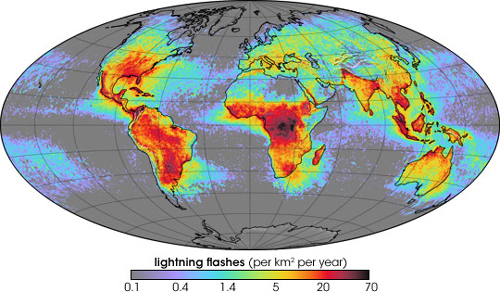
During last week’s field trip, we were treated to several spectacular evening thunderstorms of the kind that you very rarely get to see back in the UK. The massive forks of lightning arcing down from the sky during these storms were certainly awe-inspiring, but as I sit back in my office analysing preliminary demagnetisation data from my KwaZulu Natal samples, I’m starting to realise that this spectacle comes at a price.
It shouldn’t be difficult to see why lightning might be a problem for us palaeomagicians: a lightning strike on exposed rocks will briefly cause currents of 10,000 amps or more to course through them. Strong currents generate strong magnetic fields. Strong magnetic fields will reorient the magnetic grains to a new (and, in the case of a lightning strike, completely random) direction. This can easily wipe out any trace of the ancient signals I’m searching for.
Unfortunately for me, this is much more of a problem here in South Africa than it ever was in New Zealand. The map below shows the global density of lightning flashes (note that not all of these will strike the ground) over the average year, courtesy of the Earth Observatory. There is a strong latitudinal dependence, with equatorial regions experiencing many more strikes per square kilometre per year than higher latitudes, and although it doesn’t fare quite as badly in the electrocution stakes as equatorial Africa, South Africa still experiences a fair amount of activity – especially in that rather disturbing red patch on the west coast, displeasingly centred on my field area.

The problem is exacerbated by the fact that the South African landscape is pretty old – the last uplift event of any significance occurred 20 million years ago, and that only slightly changed the topography produced by a more major bout of uplift and erosion associated with plume-related rifting back in the Cretaceous. Thus, many of the rocks I’m sampling may have been sitting under lightning-filled skies for a good long time, greatly increasing the chances of them being struck and magnetically scrambled.
I’ve done all I can to avoid this problem – taking samples from valleys rather than hills, and targeting exposures freshly exposed by rivers – but I’m seeing an awful lot of random directions emerging from my data, so random (most overprints will at least show some consistency between different samples) that I’m starting to suspect that lightning-induced remanences are contaminating what was already going to be a complicated dataset.
Hopefully, with careful analysis I can identify most of the lightning-affected samples (they will often have a much stronger magnetization than the surrounding rocks, for example), and in some cases the demagnetization techniques I’m using might remove the overprint to reveal a more useful signal. But quite frankly, photogenic as lightning is, I could do without quite so much of it harassing my poor Archean volcanics.



Comments (8)